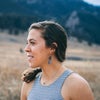The North Face Chrysalis 20 ($375)

Best for Weight Savings
If pack space is limited and distance is the goal, the Chrysalis is a trustworthy companion. It weighs just under two pounds and packs down to the size of a bread loaf, courtesy of 900-fill down. For this reason, one tester brought it along for 50 miles and two 22-degree nights in Utah’s Bears Ears National Monument. “After beating up my body all day, the anticipation of crawling into this soft cocoon was the motivation I needed to finish the hike back to camp,” our tester said, crediting the 64-inch shoulder, 59-inch hip, and extra-roomy 47.5-inch footbox girths. On another trip, into Wyoming’s Wind River Range, our tester packed the Chrysalis among climbing equipment. Its abrasion-resistant ripstop nylon compression sack emerged unscathed, though the bag’s 15-denier ripstop nylon shell (coated with a non-PFC DWR finish) is finer than most. Weight savings come from reduced insulation in the bottom panels (pair this bag with a high-R-value sleeping pad) and a smaller than average hood, which doesn’t hold a pillow inside. 1.9 lbs (regular); 20°; unisex regular, long
Sitka Kelvin Aerolite 30 ($399)

Best for Versatility
Why choose between a sleeping bag and a parka when you can have both? When zipped, the Kelvin Aerolite takes the shape of a traditional mummy bag. But it’s the multifunctional design that helps justify the admittedly high price: a two-way, full-length center zipper allows you to roll the footbox up and stow it via an aluminum hook and a nylon webbing loop. That, plus zippered arm holes ringed with draft tubes, transform the bag into a knee-length layer for hanging around camp. “Waiting for the sun to warm the Zion West Rim Trail, I converted the bag to a jacket and happily got up to start the group coffee,” one tester said. The synthetic fill kept another tester warm in 32-degree temps in Denali National Park. The bag’s 66-inch chest and 60-inch hip girths offer room to layer. 2.3 lbs (regular); 30°; unisex regular, long
Mammut 32 Trail ($100)

Best Value
Weighing just over three pounds and packing down to the size of a large watermelon, this budget-friendly synthetic bag shines for car camping trips and on short backpacking excursions. The Trail’s 62-inch shoulder and hip girths, plus a 30-inch footbox, kept one tester cozy but not claustrophobic during a rainy, 32-degree night at 11,000 feet on Colorado’s Berthoud Pass. On a 55-degree night in Chatfield State Park, Colorado, the oversize hood fit our tester’s favorite pillow from home and the full-length, two-way zipper kept clamminess at bay. The Trail’s shredded synthetic insulation allows for a baffle-less design, so there are no stitch holes to let heat escape and fewer threads to tear or pull. While this construction doesn’t allow the Trail 32°F to loft up, testers reported the synthetic fill doesn’t clump, and when temps dropped to freezing, the warmth was evenly distributed from head to toe. The bag’s 63-denier polyester shell is more durable than most. 3.1 lbs (regular); 32°; unisex regular
Montbell Seamless Burrow Bag #3 ($159)

Best for Warm Weather
On the hottest nights, we chose the Seamless Burrow Bag. The synthetic insulation is minimal, but it lofts more than similar bags. Credit a combination of cylindrical and angular polyester fibers, which stack like a losing game of Tetris and thus increase airiness. One tester reported that he didn’t sweat out the bag after five 45-degree nights in North Carolina’s Great Smoky Mountains National Park. On a two-week road trip down the Pacific coast, another tester used the full-length, two-way zipper to ventilate and reported that the DWR treatment repelled condensation on muggy mornings. Comfort bonus: the bag’s seamless construction trades baffles for internal elastic stitching that expands and contracts to match your sleeping position. The Seamless Burrow packs down to the size of a rugby ball. 2.1 lbs; 32°; unisex regular, long
Exped Ultra 3R ($150)

Best for Comfort
Striking a balance between lightness and comfort, the Ultra 3R pad helps you go the extra backcountry mile. “It kept my pack weight down for one of my longest mileage days to date,” one tester said after heading into Wyoming’s Titcomb Basin. Another tester, after a trip in Oregon’s Wallowa-Whitman National Forest, lauded the pad’s three-inch thickness, fortified with insulating and cushy microfibers. “It was comfortable in all sleeping positions,” said the tester. “My knees, back, and shoulders never felt uncomfortable.” The 72-by-20.5-inch rectangular pad has lengthwise baffles, wider at the edges and slimmer in the middle, creating a cradling effect to keep sleepers centered. The Ultra 3R’s recycled, 20-denier ripstop polyester face fabric offers average durability, and an inflation sack eases setup. 1 lb (medium); 2.9 R-value; medium, medium/wide, long/wide
NEMO Astro Insulated ($140)

Best for the Environment
After more than a decade of success, this time-tested pad gets a sustainability makeover for 2022. For one thing, its 75-denier polyester shell is now 100 percent recycled. Still, it endured seven nights of sleeping directly on California’s High Sierra granite without signs of abrasion. Its rectangular shape—72 by 20 inches, and 3.5 inches thick—kept testers warm on a ten-day backpacking trip in Colorado’s San Juan Mountains, where temps dropped below 40 degrees. A 2.6 R-value provides three-season comfort, thanks to 100 percent post-consumer recycled synthetic insulation. Still, the Astro Insulated packs down a bit smaller than a Nalgene. The included pump-sack reduces the blowup time from three-plus minutes to just under one and can extend the pad’s life by keeping delamination and mold-growing moisture at bay. (The updated non-insulated Astro now clocks a 1.5 R-value and packs slightly wider than a tube of cinnamon rolls.) 1.5 lbs (regular); 2.6 R-value; regular, long/wide


